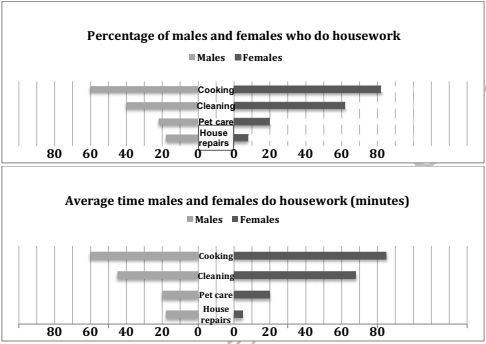Part 1
You should spend about 20 minutes on this task. The first chart below shows the percentages of women and men in a country involved in some kinds of home tasks (cooking, cleaning, pet caring and repairing the house. The second chart shows the amount of time each gender spent on each task per day. Summarise the information by selecting and reporting the main features and make comparisons where relevant. You should write at least 150 words.

The bar charts present data on the engagement of men and women in various household tasks and the time they allocate to these chores daily in a specific country. A clear trend can be discerned(포착되다) from the charts: women are shown to participate more and spend more time on home tasks than men.
In terms of involvement, over 80% of women engage in cooking and cleaning, compared to less than 70% of men for the same tasks. Pet care and house repairs show a lesser gender discrepancy, with approximately 60% of females and around 50% of males involved in pet care, while house repairs are performed by slightly over 20% of women and nearly 30% of men.
Regarding the average time spent, women dedicate roughly 70 minutes to cooking and 60 minutes to cleaning daily, significnatly surpassing men, who allocate about 30 minutes to each of these tasks. Pet care sees both genders spending close to 50 minutes, indicating a more balanced distribution of time. The most notable difference is seen in house repairs, where men spend approximately 20 minutes daily-double the time women contribute to this chore.
The charts collectively suggest a traditional division of labor, with women taking on more of the daily cooking and cleaning responsibilities, while men are more involved in occasional tasks like house repairs. The data implies(=indicates) that while there is some overlap in activities like pet care, significant disparities remain in how household labor is divided by gender.
Part 2
You should spend about 40 minutes on this task. Some people think that governments should ban dangerous sports, while others think people should have freedom to do any sports or activity. Discuss both views and give your own opinion You should write at least 250 words.
The debate over government regulation of hazardous sports is polarized. Advocates for prohibition argue that such measures are imperative(= vitally important, crucial, essential) for public safety, whereas opponents contend that they infringe upon(= undermine, diminish) personal freedom. I am inclined to support the latter viewpoint, believing in the paramount importance of individual liberty in choosing recreational activities.
Critics of dangerous sports assert that these activities pose significant risks not only to participants but also to society at large. High-risk endeavors, such as scaling skyscrapers or engaging in(=participate in, join in) mixed martial arts without protective gear, are fraught with(=full of, filled with) the potential for grave(= serious) injuries. Moreover, media sensationalization of theses sports can influence impressionable(=easily influenced) youth, leading to reckless attempts to emulate(=imitate, copy) perilous(=dangerous) feats, thereby escalating(=increase) societal risk.
Conversely, proponents(=advocate) of unrestricted access to all sports emphasize the fundamental right to personal freedom. They argue that while such activities carry inherent dangers, individuals are likely to adopt precautionary measures to mitigate(=alleviate, reduce, diminish) risks. Adquate training and education on safety protocols can further reduce the likelihood(=probability, chance) of injuries, enabling enthusiasts to safely engage in extreme sports.
My stance aligns with the advocates of freedom. I believe that liberty, a cornerstone value, should take precedence over safety concerns. In a modern society, individuals ought to have the autonomy to explore their interests, provided they are well-prepared and informed. Moreover, the exploration of new and potentially hazardous sports can spur(=stimulate, encourage) innovation, leading to the emergence of new industries and significant economic contributions.
In conclusion, while the safety concerns associated with dangerous sports are valid, the freedom to choose one's recreational activities is a fundamental right that should not be curtailed(= reduce, diminish). With proper education and training, the risks associated with these sports can be effectively managed, allowing for both personal fulfillment and societal advancement.
'영어 공부 > IELTS' 카테고리의 다른 글
| IELTS Voca(3) Day 11 ~ Day 15 (0) | 2024.03.01 |
|---|---|
| IELTS Speaking 기출 - Part 2&3(5) Street market (0) | 2024.02.27 |
| IELTS Speaking 기출 - Part 1(5) Celebrity news (0) | 2024.02.24 |
| IELTS Speaking 기출 - Part 2&3(4) Finish Quickly (0) | 2024.02.22 |
| IELTS Speaking 기출 - Part 1(4) Feeling bored (0) | 2024.02.21 |


